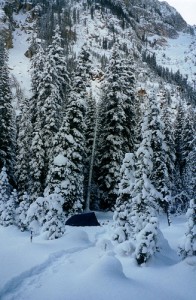Winter Camping-It’s Cool!
Most people think of camping as a summer event, early fall at the latest. Well believe it, or not there are many people who actually prefer winter camping. (Personally, the juries still out for this camper). Winter camping is available in several State and National parks, such as Yellowstone National Park in Wyoming, Montana and Idaho, and in the Shenandoah National Park in Virginia.
Now we are talking about backcountry camping here, not some cozy heated cabin, though that is another option. Even if you’ve camped these areas before in the summer, winter camping will provide a whole new experience. Not only will the landscape be different, the wildlife you may see will too. So how do you prepare for winter camping?
Permits & Applications
Most parks require permits for winter camping. Some charge a fee, some don’t. Be sure to check ahead of time incase reservations are necessary. This is for the camper’s safety as well as the parks. Also, not all areas are open for camping in the winter months. Applications for some areas are necessary months in advance, while in others it depends on weather conditions. There are restrictions some of the time on the number of campers per campsite. If you go to all the trouble of hiking in, you don’t want to camp right on top of someone else.
Equipment
Weather may be even more predictable in the winter, than the summer. It can get very cold. You need to be prepared, however, if you are hiking into a backcountry campsite you don’t want to be overloaded.
-
Obviously you are going to need a backpack. An internal frame pack is a better choice than an external frame, in case you fall on the snow or ice.
-
A four-season tent is advisable. A four-season tent is built to hold up in extreme weather conditions. It costs more, and weighs more. But do you want to shiver all night long?
-
Snow stakes are special tent stakes that are meant for use in snow and on frozen ground.
-
There are special sleeping bags for winter camping. Cold weather sleeping bags will keep you warm in minus 10 degrees to plus 10 degrees. Winter/Extreme sleeping bags will keep you warm in minus 10 degrees and below.
-
A small Wisk broom is beneficial to sweep snow out of the tent.
-
Candle lantern or other light source
-
An expedition quality cooking stove and fuel. Plan on ½ pint of white gas per person per day, and include an extra bottle for emergencies.
-
Nesting pots with lids.
-
Insulated mug for food.
-
Cooking and eating utensils (Plastic is best in cold weather)
-
Waterproof matches
-
Garbage bags and Ziploc freezer bags (most backcountry campgrounds operate on the pack it in pack it out plan-this includes toilet paper!)
-
Food (opt for hi-energy foods, leave the salads at home!)
-
Water and purification tablets. Remember-do not eat snow it lowers the body temperature and may increase the risk of hypothermia.
Clothing
-
Everyone knows about dressing in layers to stay warm. Start from the inside and work out.
-
Long underwear-tops and bottoms. These should be made out of a synthetic material, or wool blend.
-
Pants of either wool or fleece
-
A sweater of wool or fleece
-
Insulated overpants if the weather is extremely cold.
-
A down or synthetic filled jacket with a hood.
-
Glove liners
-
Wool gloves or mittens
-
A stocking cap and or balaclava
-
Ski goggles
Footwear
-
Liner socks made from polypropylene
-
Heavyweight wool socks
-
Winter hiking boots (make sure your boots have been fit with your wool socks on)
-
Optional items include cross-country skiing gear and climbing gear.
Now that you have all your gear assembled, make sure to abide by the backcountry camping etiquette rules.
-
Pack it in pack it out
-
Dispose of waste properly. (Bury solid human waste in holes at least 6”-8” deep and 100 feet from any water sources, trails, or camps.
-
Use biodegradable soap to wash dishes and yourself, and do not dump the dirty water into any streams.
-
Don’t camp to close to other campers
-
Don’t camp within 100 feet of lakes, streams or water sources
-
Don’t camp to close to trails (this is for your privacy and the privacy of other campers)
-
Keep campsites and campfires small. If campfires are allowed, use only dead wood-do not damage life trees.
-
Be courteous to other hikers and campers. Yield to others on the trail, step to the downhill side of the trail if you encounter a pack animal.
Stay warm and have a great time!
By Sandra M Webster
Photo: http://flickr.com/photos/johndale/2474999414/Credit John Dale (Flikr)


